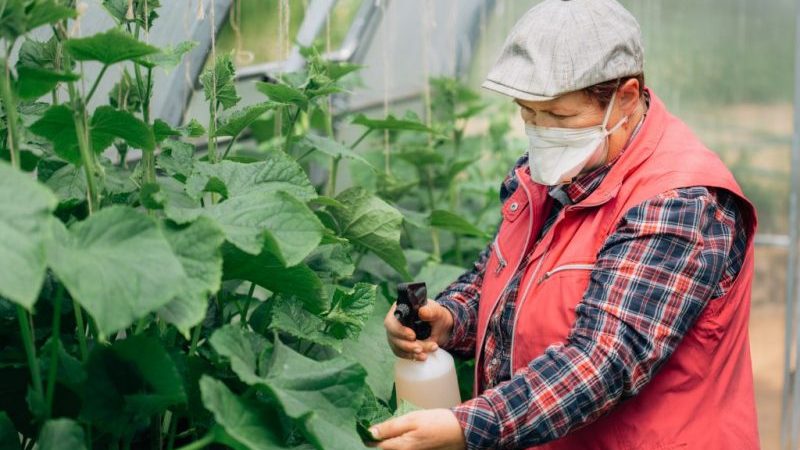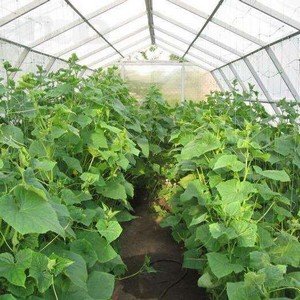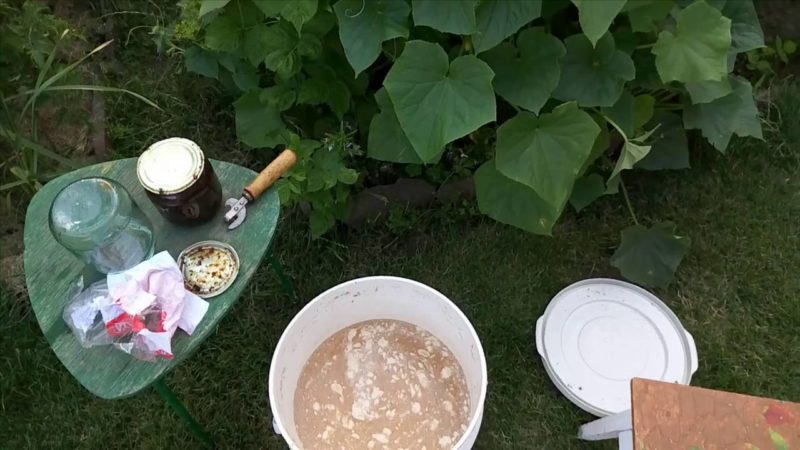What dressing can be used for cucumbers in a greenhouse during fruiting
Top dressing is the most important condition for caring for greenhouse cucumbers. The procedure is carried out regularly during the entire fruiting period. To do this, organic and inorganic fertilizers are alternated, spraying the plant over the leaf and watering at the root. They are treated with growth biostimulants, folk remedies are used to increase the yield and fight pests and diseases.
From the article, you will learn how to feed cucumbers in a greenhouse during the fruiting period and what are the nuances of fertilizing indoors.
The content of the article
Do I need to feed greenhouse cucumbers during the fruiting period
During fruiting, cucumbers grow, bloom and "pour" the fruits... They are fed during flowering to increase the number of ovaries, prevent deformation of fruits and increase the period of fruiting. During this period, potassium and nitrogen are especially necessary for cucumbers.
 Top dressing is carried out both at the root and by spraying along the entire length of the lash.
Top dressing is carried out both at the root and by spraying along the entire length of the lash.
They use organic and mineral fertilizers - every week, alternating. Potassium nitrate is best suited during this period. Dilute 25-30 g of the drug into 10 liters of water.
Fertilizer types and recipes, as well as greenhouse application schemes
Consider which fertilizers are organic and which are mineral, and how to apply each group.
Organic
Organic fertilizers are made independently from all kinds of infusions from herbs, bird droppings, cow dung and wood ash. They are alternated with mineral fertilizers or used separately.
Cucumbers are fed with fermented herb infusion. Take young shredded shoots of nettle and dandelion, mix and put in a container for two-thirds of the volume, pour water and cover with a lid. In hot weather, the infusion will begin to ferment and will be ready in 7-10 days.
As soon as there is abundant foam and an unpleasant odor, this means that the solution is ready. To speed up the process and increase nutritional value, so-called EM preparations are added there: yeast, stale bread, a glass of humus or manure. The infusion is diluted five times with water and poured onto wet soil under each plant, 0.5-1 l.
Reference! When EM preparations are added to the herbal solution, it begins to smell like mash or kvass.
Ash infusion is considered an effective top dressing. A glass of ash is dissolved in 10 liters of water and insisted for a day. Each plant is poured into 1 liter of solution.
Reference! Wood ash contains dozens of trace elements necessary for plants, in particular phosphorus, potassium and calcium. They make infusions from it or simply sprinkle them under the plant in moist soil, then loosen them well.
To extend the fruiting period of cucumbers, an infusion of dry rotten hay is used, it is insisted in a warm place for 48 hours. The hay stick contained in it fights pathogenic bacteria and fungi, which helps the cucumber grow and bear fruit longer.
The required amount of mineral and organic substances necessary for the development of fruits and the strengthening of the plant is contained in a solution of cow dung. To prepare it, take cow dung and water in proportions of 1: 5 and insist for two weeks.
An excellent fruiting stimulant is a daily infusion of onion husks and boiling water. It is diluted 1:10 and poured over cucumbers.
Mineral
Mineral fertilizers include:
- nitrogen;
- phosphoric;
- potash;
- phosphorus-potassium;
- complex fertilizers.
Mineral fertilizers are used throughout the entire fruiting period, for this they use both universal dressings, which are created only for cucumbers, and fertilizer mixtures prepared independently.
Reference! Liquid and granular complex mineral fertilizers have been produced especially for cucumbers.
For feeding in warm and hot weather, use the following feeding:
- 25-30 g of potassium nitrate is diluted in 10 liters of water;
- 50 g of urea is diluted in 10 liters of water.
Each bush is watered with it in an amount of 1 liter into moist soil.
In cold and wet weather, spray the leaves with a solution of 10-12 g of urea, diluted in 10 liters of water.
Important! At the same time, cucumbers are not watered or sprayed with mineral fertilizers. Plants thrive when the two are alternated.
To prolong the fruiting of cucumbers in a greenhouse, they are sprayed with a solution of 15 g of urea and 10 liters of water. Or pour a mixture of 30 g of baking soda dissolved in 10 liters of water under the plant. The nitrogen contained in urea will not give leaves turn yellow, and baking soda will protect the soil from pathogenic microorganisms and maintain the desired level of soil acidity.
Biostimulants
Recently, stimulants and growth regulators for cucumbers have become popular among gardeners. Let's consider the most effective ones.
"Etamon" stimulates root growth. When applied simultaneously with foliar fertilization, it increases its effect. Increases the percentage of seed germination and regulates the ratio of the size of roots and ground parts of the crop.
"Humin" - biostimulator of plant growth with a minimum content of impurities. It doubles the yield and strengthens plant immunity. Available in liquid form and mulch paste.
"Silk" stimulates the development of female flowers, increases the color saturation of the fruit, promotes the appearance of ovaries a few days ahead of schedule. They can be sprinkled with cucumbers for ovary in the greenhouse. The drug is used to prevent diseases, stimulate the immune system. Helps plants develop frost and drought resistance.
"Azovit" - biofertilizer based on live bacteria with nitrogen-fixing properties. Increases productivity and environmental friendliness of products, produces active substances that activate vegetation, increases plant immunity to diseases.
Ferovit - cure for iron chlorosis. It is also used to normalize the soil before planting crops in greenhouses.
Folk remedies

The ability of cucumbers to accumulate nitrates makes gardeners use folk remedies.
100 g of yeast is dissolved in 10 liters of water and insisted for a day. Cucumbers are poured with this solution in warm or hot weather, 1 liter at the root.
Fill two-thirds of the container with dry black bread, pour warm water and press down with a heavy load so that the bread does not float. After seven days, the infusion can be used by diluting it three times - 0.5 liters for each bush.
To speed up the ripening process of cucumbers, they are sprayed with a solution of boric acid - 0.25 tsp. boric acid per 10 liters of water. Spray on a leaf every week.
A solution of 30 g of soda and 10 l of water is used to re-form the fruit. They are watered at the root once a week.
What top dressing are suitable in the fight against pests and diseases
Some mineral fertilizers and fertilizing will protect cucumbers from diseases and pests.
The most common diseases of cucumbers are powdery mildew and downy mildew (downy mildew).
An excellent remedy for them is wood ash. Ash is sprinkled, watered or sprayed with a solution of plants. It is safe, so even fruits can be processed with it.
Important! Cucumbers are sprayed or watered only with warm water at a temperature of 25-28 ° C. Before root dressing, cucumbers are watered abundantly.
When the first signs of powdery mildew appear, the potassium content in the dressings is increased, this is achieved with the help of ash.
Disease prevention is carried out with a solution of 10 liters of water, 1 tbsp. wood ash and 800 g of cow dung. The mixture is infused and filtered for a day. Water at the root of 0.5 or spray on the leaves.
Important! Spraying of plants is carried out 6-7 times, every 10-12 days, different solutions are used.
For the prevention and control of powdery mildew, a mixture of 3 g of potassium permanganate and 10 liters of water is used. Spraying is carried out from above and necessarily from the bottom of the sheet.
Potassium permanganate can be replaced with soda ash - 50 g per 10 liters of water. Sometimes 30 g of liquid soap is added to the solution.
For prophylactic purposes against powdery mildew, plants are sprayed with milk whey. Lactic acid has a detrimental effect on pathogenic fungi, preventing the development of infection.
In the fight against aphids and other pests, the treatment of cucumbers with a solution prepared from a bucket of water and 3 tbsp. l. ammonia... In this way, they not only scare off pests, but also feed the plants. Repeat it every 10-14 days.
Ash is also used against aphids - when it appears, cucumbers pollinate ash... It will not destroy the pest, but it creates unfavorable conditions for its habitat. Leaves damaged by pests are removed so that they do not take away the strength from the plant.
A solution of 100 g of superphosphates, 50 g of potassium chloride and 10 liters of water is used for pest control, while feeding cucumbers. It is better for them to spray the crop in the evening.
What dressings can not be fertilized for cucumbers during fruiting

During fruiting, cucumbers should not be fed with chicken droppings: it will give a rapid growth of green mass and stepchildren, and fruit set will sharply decrease.
Important! Cucumbers have the ability to quickly accumulate nitrates, therefore, the doses of fertilizers do not exceed, but feeding spend every two weeks, but not earlier. In this case, it is best to combine root dressing and spraying along the lashes.
Do not fertilize with formulations made by eye: strictly follow the instructions. Do not overuse feeding, observe the time interval between them.
With an overdose of potassium the fruits will grow irregular shape. With a lack of nitrogen in the soil, the fruits sharpen at the lower end and turn white.
Conclusion
During fruiting, cucumbers in a greenhouse not only can, but also need to be fed. This is done in order to get a healthy, not deformed crop and to prolong the fruiting period.
Plants are fed both under the root and by spraying along the entire lash on the leaves. They use mineral and organic fertilizers, store and homemade. The main thing is not to abuse fertilizers and not to use preparations that are not intended for the fruiting period.